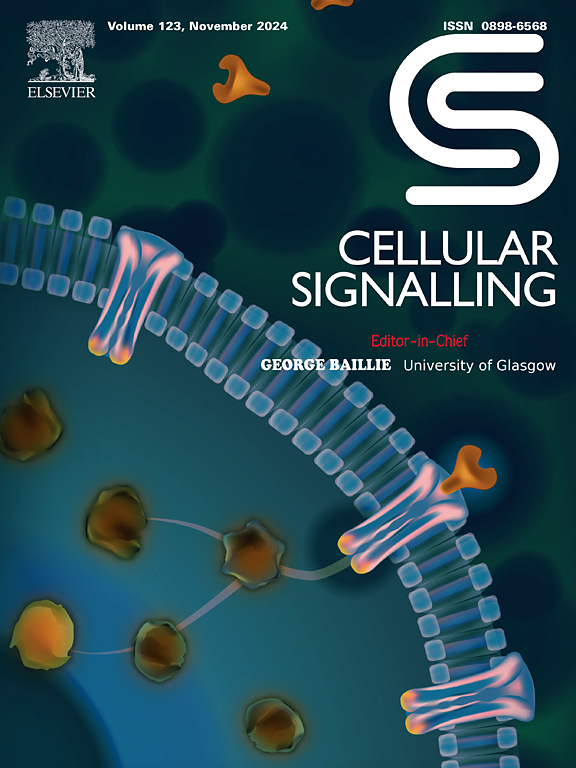瑞舒伐他汀通过Ca2+触发的内质网应激途径抑制胰腺癌的癌变。
IF 4.4
2区 生物学
Q2 CELL BIOLOGY
引用次数: 0
摘要
背景:胰腺癌由于其晚期诊断、侵袭性进展和对现有治疗方法的高耐药性,仍然是最具挑战性的恶性肿瘤之一。瑞舒伐他汀(ROV),以其降血脂作用而闻名,可显著抑制前列腺癌细胞的克隆生成能力和上皮-间质转化(EMT)。然而,ROV在PC中的抗癌机制尚未得到充分的探讨。目的:研究ROV对PC细胞的潜在抗癌作用,并探讨其作用机制。方法:采用MTT法检测细胞毒性,荧光显微镜观察上皮-间质转化(EMT)标志物、Ca2+水平和内质网(ER)应激。RNA-seq分析发现ROV处理后mRNA表达显著变化。此外,通过western blotting和免疫组织化学(IHC)检测细胞周期、EMT、Ca2+信号和内质网应激(ERS)相关蛋白在体外和体内的表达。结果:ROV通过在G1/S期阻滞细胞周期和部分降低EMT过程中细胞的流动性来抑制PC细胞的增殖。通过RNA-seq共鉴定和分析了1336个差异显著的rna (P 1),揭示了ROV处理的PC细胞中的Ca2+和ER通路。ROV处理显著改变细胞内Ca2+水平,触发ERS通路并调节Ca2+/CaM/CaMKII/ERK通路。此外,ROV抑制Ca2+和ERS通路中的关键蛋白,导致细胞增殖、流动性降低和G1/S期阻滞。在肿瘤组织中,Ki67、EMT标记物、钙调素和ATF6的表达证实了体外研究结果。结论:ROV通过Ca2+/CaM/CaMKII/ERK和Ca2+介导的ERS通路抑制EMT过程,从而抑制PC细胞的增殖和转移,显示了其作为PC预防和治疗药物的潜力。本文章由计算机程序翻译,如有差异,请以英文原文为准。

Rosuvastatin inhibits carcinogenesis through Ca2+ triggered endoplasmic reticulum stress pathway in pancreatic cancer
Background
Pancreatic cancer remains one of the most challenging malignancies to treat due to its late-stage diagnosis, aggressive progression, and high resistance to existing therapies. Rosuvastatin (ROV), known for its hypolipidemic effects, which significantly inhibited clonogenic capacity and epithelial-mesenchymal transition (EMT) in prostate cancer cells. However, the anti-cancer mechanisms of ROV in PC have not yet been fully explored.
Purpose
This study aimed to investigate the potential anti-cancer effects of ROV on PC cells and to elucidate the underlying mechanisms.
Methods
Cytotoxicity was detected via MTT assay, while epithelial-mesenchymal transition (EMT) markers, Ca2+ levels, and endoplasmic reticulum (ER) stress were observed with fluorescence microscopy. RNA-seq analysis was used to identify significantly changed mRNA expression following ROV treatment. Additionally, western blotting and immunohistochemistry (IHC) were conducted to examine proteins involving in the cell cycle, EMT, Ca2+ signaling, and endoplasmic reticulum stress (ERS) in vitro and in vivo.
Results
ROV inhibited PC cell proliferation by arresting the cell cycle at the G1/S phase and partially reducing cell mobility during the EMT process. A total of 1336 significantly different RNAs (P < 0.05 and |logFC|>1) were identified and analyzed through RNA-seq, revealing the Ca2+ and ER pathways in PC cells treated with ROV. ROV treatment significantly altered the level of intracellular Ca2+, triggering the ERS pathway and modulating the Ca2+/CaM/CaMKII/ERK pathway. Furthermore, ROV inhibited key proteins within the Ca2+ and ERS pathways, leading to reduced cell proliferation, mobility and G1/S phase arrest. In tumor tissues, the expression of Ki67, EMT markers, Calmodulin, and ATF6 corroborated the in vitro findings.
Conclusion
ROV inhibited proliferation and metastasis in PC cells by inhibiting the EMT process through the Ca2+/CaM/CaMKII/ERK and Ca2+-mediated ERS pathways, highlighting its potential as a prophylactic and therapeutic agent for PC.
求助全文
通过发布文献求助,成功后即可免费获取论文全文。
去求助
来源期刊

Cellular signalling
生物-细胞生物学
CiteScore
8.40
自引率
0.00%
发文量
250
审稿时长
27 days
期刊介绍:
Cellular Signalling publishes original research describing fundamental and clinical findings on the mechanisms, actions and structural components of cellular signalling systems in vitro and in vivo.
Cellular Signalling aims at full length research papers defining signalling systems ranging from microorganisms to cells, tissues and higher organisms.
 求助内容:
求助内容: 应助结果提醒方式:
应助结果提醒方式:


